ET22SWE0020 - Variable Refrigerant Flow (VRF) Refrigerant Management Market Assessment
Building electrification initiatives are resulting in an explosion of electrified heating and cooling (heat pump) systems being installed in residential and commercial buildings. Electrifying the building sector is a critical step toward meeting California’s decarbonization goals; however, the refrigerants used in heat pumps contain greenhouse gases (GHGs) thousands of times more warming than carbon dioxide and even methane. While keeping refrigerant from leaking into the atmosphere is critical for all heat pump applications, large commercial building systems often require extensive field-installed piping and significant refrigerant charge (amount)- a combination that creates high emissions potential. As these heat pumps, increasingly referred to as variable refrigerant flow (VRF) systems, replace fossil-fuel powered equipment in both new and existing buildings, the potential GHG impact of refrigerant leaks needs to be understood and cost-effective mitigation strategies must be incorporated into building electrification initiatives. In addition to the direct global warming impact of refrigerant leaked into the atmosphere, studies have shown that heat pump systems operating with insufficient refrigerant also consume more energy, contributing to higher electric bills and power generation emissions. This market assessment will provide clarity on anticipated market adoption of VRF systems, the lifetime GHG emissions potential of those systems if no action is taken, and the mitigation strategies that can be implemented to maximize that environmental, economic, and social benefits of commercial heat pumps. Additionally, the project will build upon and complement the current Commercial VRF Fuel Substitution measure development activity also being performed by Energy Solutions, by bringing in new market study activities including stakeholder engagement and a deeper focus on new system installations. The measure development project is focused on the measure package / work paper for VRF’s using newer energy models. It is reevaluating the measure as a prescriptive offering for retrofits or gut rehab/major renovations. With this VRF Refrigerant Management market study we will review past research and lessons learned to maximize the benefits of adoption of VRF’s by getting ahead of potential negative issues associated with leaks and/or improper installation and maintenance.

